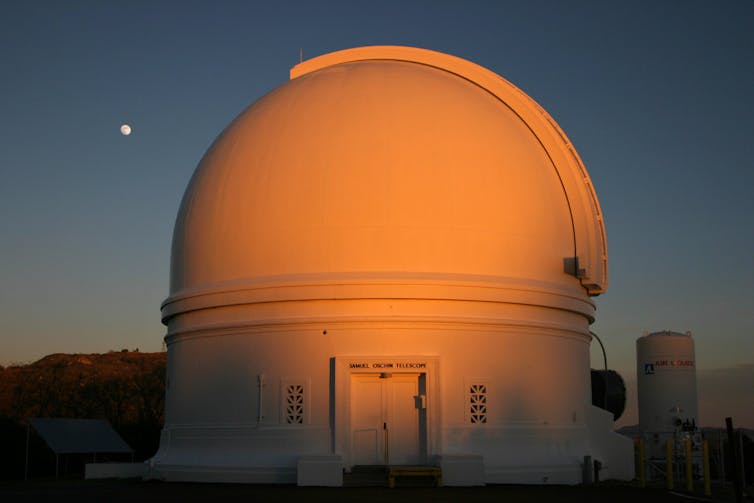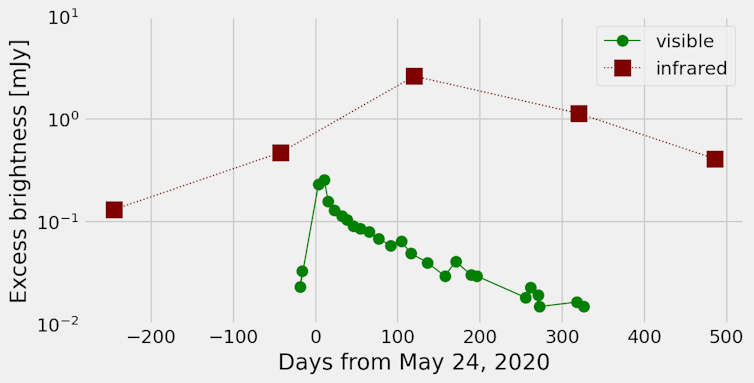Astronomers just saw a star eat a planet – an astrophysicist on the team explains the first-of-its-kind discovery
For the first time, astronomers have captured images that show a star consuming one of its planets. The star, named ZTF SLRN-2020, is located in the Milky Way galaxy, in the constellation Aquila. As the star swallowed its planet, the star brightened to 100 times its normal level, allowing the 26-person team of astronomers I worked with to detect this event as it happened.
I am a theoretical astrophysicist, and I developed the computer models that our team uses to interpret the data we collect from telescopes. Although we only see the effects on the star, not the planet directly, our team is confident that the event we witnessed was a star swallowing its planet. Witnessing such an event for the first time has confirmed the long-standing assumption that stars swallow their planets and has illuminated how this fascinating process plays out.

Caltech/Palomar, CC BY-NC
Finding a flash in the dynamic night sky
The team I work with searches for the bursts of light and gas that occur when two stars merge into a bigger, single star. To do this, we have been using data from the Zwicky Transient Facility, a telescope located on Palomar Mountain in Southern California. It takes nightly images of broad swaths of the sky, and astronomers can then compare these images to find stars that change in brightness over time, or what are called astronomical transients.
Finding stars that change in brightness isn’t the challenge – it’s sorting out the cause behind any specific change to a star. As my colleague Kishalay De likes to say, “There are plenty of things in the sky that go boom.” The trick to identifying stellar mergers is to combine visible light – like the data collected at Palomar – with infrared data from NASA’s WISE space telescope, which has been surveying the entire sky for the past decade.
In 2020, the star ZTF SLRN-2020 suddenly became 100 times brighter in visible light over just 10 days. It then slowly started to fade back toward its normal brightness. About nine months before, the same object started to emit a lot of infrared light, too. This is exactly what it looks like when two stars merge together, with one critical difference – everything was scaled down. The brightness and total energy of this event were about a thousand times lower than any of the merging stellar pairs astronomers had found to date.
When a star swallows its planets
The idea that stars could engulf some of their planets has been a long-standing assumption in astronomy. Astronomers have long known that when stars run out of hydrogen in their cores, they get brighter and begin to increase in size.
Many planets have orbits that are smaller than the eventual size of their parent stars. So, when a star runs out of fuel and starts to expand, the planets nearby are inevitably consumed.

M. MacLeod, CC BY-ND
Interpreting a stellar flash
In the ZTF SLRN-2020 outburst, our team never saw the planet itself, only the brightening from when the star absorbed the planet. This is where combining theoretical models with the observational data allowed us to understand what the telescopes captured.
The merging of two stars into a single, bigger star is a dramatic event that throws matter out into the stars’ surroundings. A large part of my career has focused on modeling the way stellar gas moves and crashes into itself and is expelled in these moments of intense interaction.
My work has shown that the total mass of matter ejected in a merging event is proportional to the size of the objects involved in the merger. Merge two equally large stars and you see a huge disturbance. Merge one star with a much smaller companion and the event might throw out a tiny fraction of the total mass of the stars.
The energy released during ZTF SLRN-2020’s outburst was a thousand times lower than typical for a two-star merger. This implies that the object that merged with the star weighed a thousand times less than a normal star. This clue pointed our team toward a gas giant planet – like Jupiter in our own solar system, which weighs roughly a thousand times less than the Sun.
Compared to Jupiter, however, this planet must have orbited much closer to the star, with one revolution around the star only taking a few days. About 1% of stars share this configuration of a large planet orbiting incredibly close to its parent star.
Further, I think that this configuration of a big planet close to its star is important in generating the event our team saw. My past research suggests that smaller planets – or ones in more-distant orbits that only get consumed once a star has grown massively in size – might be swallowed without a detectable flash.
Learning from the real thing
From our data and modeling for ZTF SLRN-2020, our team has been able to paint a much clearer picture of how stars and planets merge. First, the planet skims across the surface of the star for many years, slowly heating up and expelling material from the star’s atmosphere. As this gas expands and cools, some of it forms molecules and dust. This cloud of dust gives the star a progressively redder color and emits increasing amounts of infrared radiation.
In the case of ZTF SLRN-2020, the orbit of the planet shrank slowly at first, then faster and faster as the planet smashed through the denser layers of the star’s atmosphere. Eventually, in just a few final days, the planet plunged below the surface of the star and was torn apart by the heat and force of the collision. This rapid injection of energy supplied heat to power ZTF SLRN-2020’s 10-day, hundredfold increase in brightness. Following this climactic moment, the star began to fade, telling our team that the planet-swallowing process was over and that the star was beginning to go back to business as usual.
While the destructive event has passed, there is still much to be learned. Next week our team will start analyzing data from the James Webb Space Telescope in the hopes of learning about the chemistry of the gas that now surrounds ZTF SLRN-2020.
Stay connected with us on social media platform for instant update click here to join our Twitter, & Facebook We are now on Telegram. Click here to join our channel (@TechiUpdate) and stay updated with the latest Technology headlines. For all the latest Technology News Click Here
